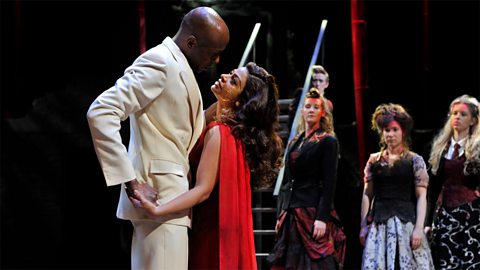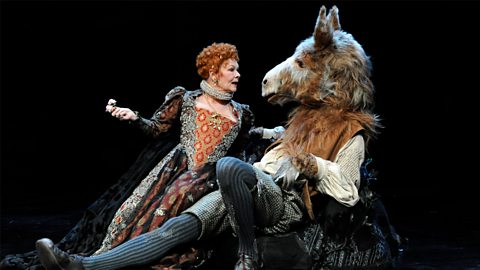Key points
A Midsummer Night’s Dream is a play by William Shakespeare that tells the story of confused lovers and fairy magic.
Themes are the main ideas that appear repeatedly in a play. Some of the important themes in A Midsummer Night’s Dream are:
- Love - romantic love causes problems and conflicts in the play.
- Appearance and reality - things are not quite what they seem in a play that includes magical worlds, tricks and confusions.
- Order and disorder - there are different types of disorders but order is restored by the end.
Did you know?
Shakespeare often uses similar themes across his plays. For example, Romeo and Juliet is a tragedy that also deals with the theme of love.
Love
Watch this video about love in A Midsummer Night's Dream:
Narrator: Love. Love is powerful. Shakespeare knew that against love, our poor brains didn’t stand a chance! In Midsummer Night’s Dream, Shakespeare…hang on. You – leave that poor brain alone! I’m sorry. Someone point the camera away. Ah good.
You lot. Do something. Love is out of control. We’re doing Midsummer Night’s Dream. Could you do a little sketch about the – run! Oh dear. Oh dear. Well, I suppose this does illustrate what happens in the play. Love does create chaos.
Love makes Hermia risk death by disobeying her father. Love makes people waste their lives loving people who don’t love them back, like Demetrius and Helena. And then we see how jealous Oberon can be! Yes, jealousy is very destructive! And then Oberon’s love potion makes everything worse before it makes it better.
Sounds quiet. Let’s take a peek. Ah. Well, in the play there’s only one way to sort out the chaos that love creates! And that’s more love! Summon Lovezilla! I’d love to show you the fight, but it’s pay per view.
In A Midsummer Night’s Dream, Shakespeare explores the problems and conflicts that can be caused by love.
Unrequited love
Helena and Demetrius suffer from unrequitedA feeling that is not returned. love at the start of the play. Helena is in love with Demetrius, but he doesn’t love her back. Demetrius loves Hermia, but she also does not return his affections.
Jealousy
Helena is jealous of Hermia because Demetrius loves Hermia, and Helena loves Demetrius. When both Demetrius and Lysander are in love with Helena because of Puck’s love potion, Hermia is jealous.
Lysander describes love as:
… swift as a shadow, short as any dream, brief as the lightning…
–
What literary device is being used in this quotation?
Lysander uses three similes to show how fleeting and quick love can be. A simile describes something by comparing it to something else, using the words ‘like’ or ‘as’. Lysander compares love to a shadow, a dream and lightning. All these images create a vivid sense of love being over quickly.
Order and disorder
Watch this video about order in A Midsummer Night's Dream:
Narrator: Order and Disorder. In Midsummer Night’s Dream, lots of things go wrong. You can get up now. C’mon, it couldn’t have been that sore. It is a comedy after all… We can expect a little disorder to happen. Ok. A lot of disorder.
For example, Hermia is at odds with her father, and Oberon and Titania are at odds with each other. The worlds of man-made law and natural law are in disorder… So much so, that nature itself goes wrong, the worlds of humans and fairies collide. Men are turned into animals… hate is turned into love, and love into confusion!
But it’s not a tragedy. It’s a comedy. The disorder is funny. For the audience at least. Shakespeare shows us that disorder can make things change for the better! It doesn’t have to be all doom and gloom disorder. Disorder can be fun! And remember, nobody dies in this play. I said – nobody dies! Nobody! Off you go! Hop it boney! Really. Poor Shakespeare.
The disruption of order creates many comical, as well as serious, moments in the play.
There is disorder within the fairy world because Titania and Oberon are in conflict. Titania claims that her dispute with Oberon about the changeling boy has created disorder in nature and changed the weather. Shakespeare often shows the natural world being affected by the actions of the characters.
Puck creates disorder in the human world, by making a mistake with the love potion and making Lysander fall in love with Helena. By the end of the play there is a happy ending for the four couples in the play. The fairy couple, Oberon and Titania, are reunited and stop arguing. The young lovers, Hermia and Lysander and Helena and Demetrius, are married alongside Theseus and Hippolyta.
What is Titania describing in this passage?
The spring, the summer,
The childing autumn, angry winter change
Their wonted liveries, and the mazed world
By their increase now knows not which is which.
–
Titania describes how her conflict with Oberon has created disorder in nature. The seasons have changed their “wonted liveries”, which means their usual clothes. This suggests that the seasons have changed their appearance. The world is “mazed”, which means amazed and confused, by this change.

Appearance and reality
Watch this video about appearance and reality:
Narrator: Appearance and reality. Have you ever seen a fairy? You’ve heard of sunglasses. Well these are night glasses. With a Midsummer lens. Try them on. I don’t know why he’s so shocked. He wrote this crazy play. You really can’t trust your senses in a fairy wood on Midsummer’s Eve.
There’s a love potion making you fall in love with anybody you see! Lysander and Demetrius both see Helena as the love of their lives! Whereas Titania falls in love with an ass-headed Bottom! And when Oberon reverses the spell, and Bottom becomes a man again, they think that what was real, was just a dream. Midsummer Night’s Dream? If Shakespeare wrote the play today, he could call it, ‘Crazy Crazy Bonkers Time’.
You going to stick them on again? Shakespeare tells us that fairyland, fantasy and dreams are great, but like Puck’s potion, can be strong medicine. Best take sparingly with a large dose of reality. Once a night on Midsummer’s Eve is quite enough.
In the play, the line between appearance and reality becomes confused. The human world cannot see the fairy world and most of the magical characters remain invisible to the human characters.
Tricks and confusions
Titania is given a love potion and falls in love with Bottom, who has been given the head of a donkey by Puck. She appears to be in love with Bottom, but in reality she is the victim of Oberon and Puck’s trick.
Oberon and Puck also create confusion in the world of the lovers. Lysander appears to be in love with Helena, but in reality he is the victim of Puck’s love potion.

The play within the play
The mechanicals struggle to understand how an audience will react to their play. They worry that the audience will think the events are real and be scared by their lion. This creates lots of comical moments for the audience.
Dreaming
At the end of the play, all the lovers think the events have happened in a dream. Puck also speaks to the audience directly and tells them to think of the play as their own dream.
Did you know?
Not everyone loved A Midsummer Night’s Dream. Samuel Pepys, a writer famous for his diaries recounting the Great Fire of London and the Great Plague, saw it in 1662. He recorded in his famous diary that the play was “the most insipid ridiculous play that ever I saw in my life”, although he also commented that he liked the dancing.
Test your knowledge
GCSE exam dates 2025
Find out everything you need to know about the 2025 GCSE exams including dates, timetables and changes to exams to get your revision in shape.

More on A Midsummer Night's Dream
Find out more by working through a topic